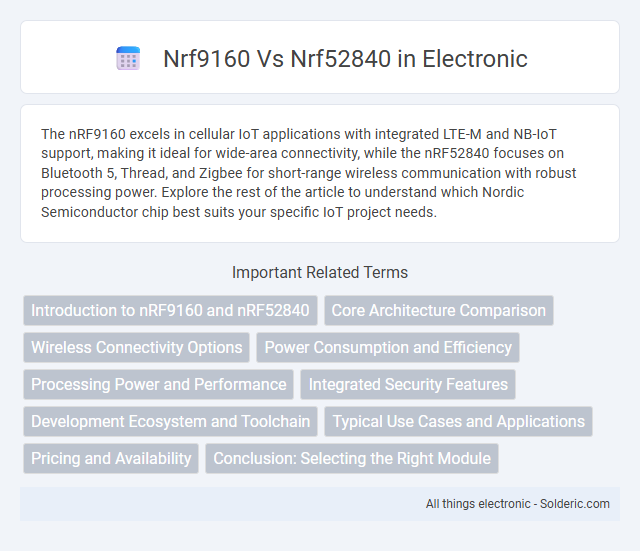The nRF9160 excels in cellular IoT applications with integrated LTE-M and NB-IoT support, making it ideal for wide-area connectivity, while the nRF52840 focuses on Bluetooth 5, Thread, and Zigbee for short-range wireless communication with robust processing power. Explore the rest of the article to understand which Nordic Semiconductor chip best suits your specific IoT project needs.
Comparison Table
| Feature | nRF9160 | nRF52840 |
|---|---|---|
| Processor | Arm Cortex-M33, 64 MHz | Arm Cortex-M4, 64 MHz |
| Cellular Connectivity | LTE-M / NB-IoT | None (Bluetooth 5.2, Thread, Zigbee) |
| Bluetooth | Not supported | Bluetooth 5.2 (Long Range, Mesh) |
| Memory | 1 MB Flash, 256 KB RAM | 1 MB Flash, 256 KB RAM |
| GPS | Integrated Multi-GNSS | Not available |
| Power Consumption | Optimized for low power LTE | Optimized for low power BLE |
| Security | Arm TrustZone, Secure Boot, Crypto | Arm CryptoCell-310, Secure Boot |
| Use Cases | Cellular IoT, asset tracking, remote monitoring | Bluetooth IoT, wearables, smart home, mesh networks |
Introduction to nRF9160 and nRF52840
The nRF9160 is a cellular IoT module featuring LTE-M and NB-IoT connectivity, designed for low-power wide area applications and equipped with an ARM Cortex-M33 processor. The nRF52840 is a multiprotocol Bluetooth 5.0 SoC with an ARM Cortex-M4 CPU, optimized for short-range wireless applications requiring high data throughput and advanced security. Both SoCs support robust IoT development but cater to different connectivity needs: cellular for nRF9160 and Bluetooth for nRF52840.
Core Architecture Comparison
The nRF9160 features an Arm Cortex-M33 core with TrustZone technology, optimized for secure cellular IoT applications, while the nRF52840 uses an Arm Cortex-M4F core, tailored for Bluetooth 5 and low-power wireless connectivity. Your choice depends on the need for cellular connectivity and enhanced security (nRF9160) versus advanced Bluetooth features and general-purpose applications (nRF52840). Both cores deliver efficient processing but cater to distinctly different IoT use cases.
Wireless Connectivity Options
The nRF9160 supports LTE-M and NB-IoT cellular connectivity, making it ideal for long-range IoT applications requiring wide-area network coverage and low power consumption. The nRF52840 features Bluetooth 5.2, Bluetooth mesh, Thread, Zigbee, and NFC, providing versatile short-range wireless options for device-to-device communication in smart home and wearable devices. Your choice depends on whether your project prioritizes cellular IoT or short-range wireless protocols.
Power Consumption and Efficiency
The nRF9160 excels in power efficiency for cellular IoT applications, featuring integrated LTE-M and NB-IoT with optimized low power modes, making it ideal for long battery life in remote deployments. In contrast, the nRF52840 offers ultra-low power consumption tailored for Bluetooth 5, Bluetooth mesh, and other short-range wireless protocols, balancing performance and energy use for wearable and IoT devices. Your choice depends on whether your application prioritizes cellular connectivity efficiency or short-range wireless power optimization.
Processing Power and Performance
The nRF9160 features an Arm Cortex-M33 processor running up to 64 MHz with integrated LTE-M and NB-IoT cellular connectivity, optimized for low-power IoT applications requiring wide-area network communication. In contrast, the nRF52840 uses an Arm Cortex-M4 CPU clocked at 64 MHz with a floating point unit, delivering robust performance for Bluetooth 5, Thread, and Zigbee protocols, excelling in short-range wireless communication tasks. While both chips offer efficient processing, the nRF9160 is tailored for cellular IoT with secure processing capabilities, whereas the nRF52840 provides higher throughput for complex Bluetooth and mesh networking applications.
Integrated Security Features
The nRF9160 features Arm TrustZone technology, a secure bootloader, and hardware-based cryptographic accelerators tailored for LTE-M and NB-IoT applications, ensuring robust cellular security. In contrast, the nRF52840 prioritizes Bluetooth 5.2 with cryptographic hardware accelerators and ARM CryptoCell-310, providing strong protection for short-range wireless communications. Both SoCs integrate secure key storage and accelerated encryption, but the nRF9160 offers enhanced security aligned with IoT cellular connectivity requirements.
Development Ecosystem and Toolchain
The nRF9160 supports the Nordic Semiconductor nRF Connect SDK, which integrates Zephyr OS and offers extensive cellular IoT development tools including LTE and GPS functionalities. In contrast, the nRF52840 leverages the nRF5 SDK and Zephyr OS, providing robust Bluetooth 5 and Thread development capabilities with a strong emphasis on low-power wireless applications. Both chips are compatible with Segger Embedded Studio, enabling streamlined debugging and programming within a consistent development environment.
Typical Use Cases and Applications
The nRF9160 excels in cellular IoT applications requiring LTE-M and NB-IoT connectivity for remote asset tracking, smart metering, and industrial monitoring. The nRF52840 is ideal for Bluetooth 5, Thread, and Zigbee supported applications such as wearable devices, smart home products, and low-power wireless peripherals. Both chips enable secure, low-power wireless communication but target distinct connectivity ecosystems tailored to their respective use cases.
Pricing and Availability
The nRF52840 offers a more budget-friendly option with widespread availability, making it suitable for cost-sensitive IoT projects. The nRF9160, designed for cellular IoT with LTE-M and NB-IoT support, typically comes at a higher price due to its advanced cellular capabilities. You should consider nRF52840 if pricing and accessibility are your primary concerns, while nRF9160 is best for applications requiring integrated cellular connectivity despite its higher cost.
Conclusion: Selecting the Right Module
Choosing between the nRF9160 and nRF52840 depends on your project's connectivity and power requirements. The nRF9160 excels in cellular IoT applications with integrated LTE-M/NB-IoT modem and GPS, making it ideal for wide-area network deployment. Your decision should prioritize long-range cellular communication for the nRF9160 or high-performance Bluetooth 5.2 with advanced peripherals offered by the nRF52840.
nrf9160 vs nrf52840 Infographic

 solderic.com
solderic.com